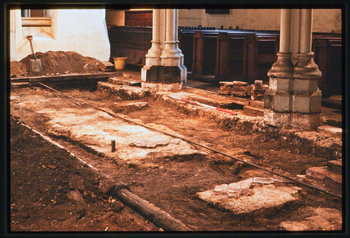St Stephen's Church, Ipswich - IAS3203
Suffolk County Council Archaeological Service, 2015. https://doi.org/10.5284/1034347. How to cite using this DOI
Data copyright © Suffolk County Council Archaeological Service unless otherwise stated
This work is licensed under the ADS Terms of Use and Access.
Primary contact
Suffolk County Council Archaeological Service
Bury Resource Centre
Hollow Road
Bury St Edmunds
IP32 7AY
Resource identifiers
- ADS Collection: 1913
- DOI:https://doi.org/10.5284/1034347
- How to cite using this DOI
Introduction

Circumstances of excavation
The conversion of this redundant church to a tourist information centre involved minor improvements. This included the removal of the pews which sat on boarded wooden floors laid on joists which rested on bare earth below. The levels of this earth were to be reduced below the level of the surrounding tiled walkways in order to lay a new solid floor at the same level. The Suffolk Archaeological Unit were granted permission by the owners, Ipswich Borough Council, to excavate the ground levels which were to be removed, providing an opportunity to examine one of the town’s churches recorded in the Domesday Book.
Following removal of the pews in 1982, two small trial trenches were excavated either side of the central walkway in the nave. In the following year these were enlarged to include the whole area which had been occupied by wooden flooring in the nave (trenches 0028 and 0029), south aisle (trench 0050) and chancel (trenches 0065 and 0070).
Site constraints
Excavations were shallow (c.15-30cm deep), being restricted to the proposed formation levels for the new floor, apart from the two trial trenches excavated in 1982 in the nave, which were 0.5m deep. Three hand-augered boreholes in the nave indicated 1.5-1.75m of deposits below current floor levels.
Dating evidence was sparse as there was little associated pottery.
Site summary
In the south aisle, there were many grave slabs and two brick-walled tombs (0055, 0064), all of which appear to have been 18th century or later. In the nave there was a brick-vaulted tomb (0033) and three unmarked graves (0002, 0008, 0014). The top of another brick-lined tomb (0071) was revealed in the north trench in the chancel (0065) and, in the south chancel trench (0070), there were the tops of a brick and septaria lined tomb (0066), a grave slab (0073) and an unmarked grave (0069).
Earlier Medieval features include robber trenches, wall stubs and distinct layers. In the north trench (0028), there two layers: a loam layer (0011), with human bones, and layer of loam with mortar underneath (0027). There was no pottery later than 12th century in these layers.
Further information can be found in the Site Summary which can be accessed by selecting the 'Reports' tab on the 'Downloads' page.






